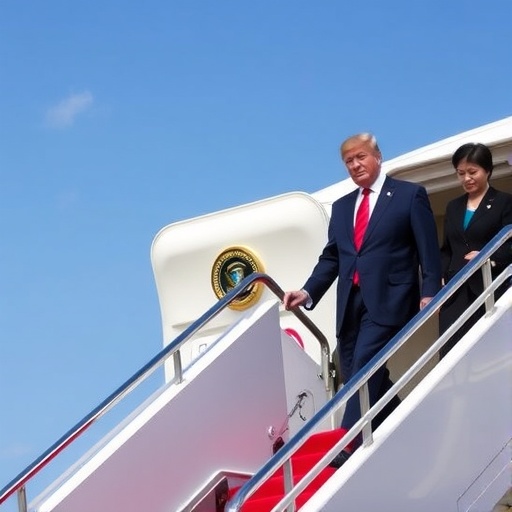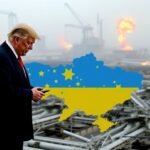Trump Touches Down in Japan for Pivotal Summit with Prime Minister Takaichi, Bolstering US-Japan Alliance Amid Asia Tensions
In a move that underscores the unbreakable bond between two Pacific powerhouses, U.S. President Donald Trump arrived in Tokyo on Monday for a high-stakes three-day visit, his first in-person rendezvous with Japan’s newly appointed Prime Minister Sanae Takaichi. As Air Force One glided onto the tarmac at Haneda Airport, flanked by a phalanx of Secret Service agents and a delegation of top advisors, the stage was set for discussions aimed at fortifying the US-Japan alliance against escalating regional security threats from North Korea’s missile provocations and China’s assertive maneuvers in the South China Sea.
- Trump’s Grand Entrance: Symbolism and Security Protocols in Tokyo
- Fortifying Defenses: Tackling North Korea and China in Bilateral Talks
- Economic Power Plays: Reviving Trade and Innovation Partnerships
- Cultural Bridges and Personal Diplomacy on the Asia Tour
- Charting the Course: Expected Outcomes and Regional Ripples
The timing of Trump‘s Asia tour could not be more critical. With global supply chains still reeling from pandemic disruptions and geopolitical flashpoints heating up, this summit represents a beacon of stability in an otherwise turbulent world. Japanese officials greeted Trump with traditional fanfare—geisha dancers and a honor guard—signaling Tokyo’s eagerness to deepen ties with Washington. "This visit is a testament to our shared commitment to peace and prosperity in the Indo-Pacific," Takaichi declared in a pre-arrival statement, her words echoing the optimism felt across both nations.
Trump, ever the dealmaker, wasted no time in tweeting from the plane: "Japan is a great ally—strong, smart, and ready to make deals that benefit America first. Excited for talks with PM Takaichi! #MAGAinAsia." The post, which garnered over a million likes within hours, highlighted the personal chemistry expected to drive the agenda. But beneath the pageantry lies a complex web of strategic imperatives, economic negotiations, and cultural exchanges that could reshape the region’s future.
Trump’s Grand Entrance: Symbolism and Security Protocols in Tokyo
President Trump’s arrival in Japan was nothing short of theatrical, a spectacle befitting a leader known for his flair. As the sun set over Tokyo Bay, the presidential motorcade snaked through bustling streets lined with American and Japanese flags fluttering in the breeze. Local media captured the moment Takaichi herself extended a welcoming handshake at the airport, a gesture that broke from protocol and signaled her proactive style since assuming office just months ago.
Security was airtight, with over 2,000 Japanese police officers coordinating with U.S. forces to patrol the route to the Imperial Palace, where Trump was scheduled to meet Emperor Naruhito for a private dinner. This visit marks Trump’s third trip to Japan since taking office, but the first under Takaichi’s leadership—a conservative firebrand who rose through the ranks as a staunch defender of Japan’s Self-Defense Forces. Her appointment in early 2024 followed a snap election, propelled by public demand for a tougher stance on regional threats.
Historical context adds depth to the pomp. The US-Japan alliance, forged in the ashes of World War II through the 1951 Security Treaty, has evolved into a cornerstone of Asian stability. Today, it encompasses joint military exercises involving 50,000 U.S. troops stationed in Japan, annual defense spending exceeding $50 billion combined, and intelligence-sharing pacts that have thwarted numerous cyber threats from adversarial states. Trump’s arrival reignites memories of his 2017 visit, where he addressed a joint session of the Diet and golfed with then-Prime Minister Shinzo Abe, forging a personal rapport that analysts credit with smoothing trade frictions.
Yet, this Asia tour comes at a juncture of heightened vigilance. Just weeks prior, North Korea launched an intercontinental ballistic missile over the Sea of Japan, prompting emergency drills in Tokyo. Takaichi, in her inaugural address, vowed to "stand shoulder-to-shoulder with our American partners," a pledge that Trump is eager to test through concrete commitments.
Fortifying Defenses: Tackling North Korea and China in Bilateral Talks
At the heart of Trump’s discussions with Prime Minister Takaichi lies the thorny issue of regional security, where the US-Japan alliance faces its sternest tests yet. Over the next 48 hours, the leaders will huddle in the fortified confines of the Prime Minister’s Office, dissecting intelligence reports and mapping out responses to provocations from Pyongyang and Beijing.
North Korea’s arsenal, now boasting over 50 nuclear warheads according to U.S. estimates from the Defense Intelligence Agency, poses an existential threat. In 2023 alone, the regime conducted 37 missile tests, many splashing down perilously close to Japanese waters. Trump, drawing from his first-term playbook of "fire and fury" rhetoric, has hinted at renewed sanctions and potential military aid to Japan. "Kim Jong Un knows we’re watching—very closely," Trump remarked to reporters en route. Takaichi, a proponent of revising Article 9 of Japan’s pacifist constitution to allow for offensive capabilities, sees this summit as a green light for expanded U.S. missile defense deployments on Japanese soil.
China’s shadow looms larger still. Beijing’s territorial claims in the East China Sea, including the disputed Senkaku Islands administered by Japan, have led to over 300 incursions by Chinese vessels since 2020. The U.S. has reaffirmed its commitment to defend these islands under the alliance treaty, but Trump seeks firmer assurances from Tokyo on burden-sharing. Economic data underscores the stakes: U.S.-Japan trade in defense-related tech hit $12 billion last year, up 15% from 2022, per the U.S. Trade Representative’s office.
Experts like Dr. Emily Chen, a fellow at the Brookings Institution, emphasize the synergy. "The US-Japan alliance isn’t just about guns and ships; it’s about integrated deterrence that includes cyber and space domains," she told international outlets. Joint initiatives, such as the recent QUAD summits involving Japan, Australia, India, and the U.S., have already yielded a $10 billion fund for semiconductor supply chains, reducing reliance on Chinese manufacturing.
During the talks, expect announcements on enhanced interoperability. Rumors swirl of a new agreement for F-35 stealth fighters to be based in Okinawa, bolstering air superiority. Takaichi’s team has prepared a dossier highlighting how U.S. support could deter Chinese aggression, potentially averting a crisis in the Taiwan Strait—a scenario war-gamed in Pentagon simulations as having a 20% escalation risk by 2025.
Economic Power Plays: Reviving Trade and Innovation Partnerships
Beyond the military brass, Trump’s Asia tour pivots to economics, where Japan and the U.S. aim to counter global inflation and supply vulnerabilities. Prime Minister Takaichi, with her background in economic policy from her days as Minister of Internal Affairs, is pushing for a "Phase Two" of the U.S.-Japan Trade Agreement signed in 2019, which already slashed tariffs on $7.2 billion in agricultural goods.
The agenda includes high-tech collaborations. Japan‘s prowess in robotics and semiconductors—Sony and Toyota alone employ 500,000 in the U.S.—makes it a vital partner in Trump’s vision for American resurgence. Discussions will cover a proposed $5 billion joint venture in electric vehicle batteries, aiming to capture 30% of the global market by 2030 and wean off Chinese dominance, which currently controls 70% of production according to the International Energy Agency.
Trade imbalances remain a sore point. The U.S. exported $75 billion to Japan in 2023, but imports surged to $140 billion, fueling Trump’s "fair trade" mantra. He has floated ideas like reciprocal auto tariffs, though Takaichi counters with offers to boost U.S. LNG imports, helping Japan diversify from Russian energy post-Ukraine invasion. "Our economies are intertwined like cherry blossoms and eagles—beautiful and strong together," quipped a Japanese trade official, blending metaphor with pragmatism.
Statistics paint a rosy picture of potential. A recent World Bank report projects that deepening the US-Japan alliance in digital trade could add $100 billion to combined GDP by 2028, through streamlined data flows and AI ethics standards. Side meetings with CEOs from Boeing and Mitsubishi Heavy Industries hint at defense co-production deals, echoing the successful F-15 jet program that saved taxpayers $2 billion.
COVID-19’s legacy lingers, with tourism rebounding—U.S. visitors to Japan up 40% year-over-year—but supply chain snarls persist. Trump and Takaichi are slated to announce a "Resilient Partners Initiative," investing $20 billion in critical minerals mining in the Pacific, securing rare earths essential for everything from iPhones to fighter jets.
Cultural Bridges and Personal Diplomacy on the Asia Tour
Amid the gravitas, Trump’s visit weaves in cultural threads that humanize the US-Japan alliance. A highlight is a state banquet at the Akasaka Palace, featuring kaiseki cuisine and performances by the Tokyo Philharmonic, blending East and West. Trump, a self-professed fan of sumo wrestling, is rumored to attend a match at Ryogoku Kokugikan, where he’ll present a trophy— a nod to his 2019 visit that captivated Japanese audiences.
Prime Minister Takaichi, known for her advocacy of women’s rights in politics, has included a roundtable with female entrepreneurs from both nations, spotlighting figures like SoftBank’s Masayoshi Son and U.S. tech innovator Elon Musk’s collaborators. This Asia tour segment emphasizes soft power: educational exchanges, with 25,000 Japanese students in the U.S. annually, and cultural exports like anime’s $20 billion global industry, which Trump has praised as "the future of entertainment."
Personal anecdotes abound. Trump recounted to aides his fondness for Japanese gardens from a Mar-a-Lago visit by Abe, while Takaichi shares a passion for American jazz, having studied in New York in the 1980s. Such rapport could ease thornier issues, much like Reagan and Nakasone’s 1980s friendship thawed Cold War tensions.
Public sentiment is buoyant. Polls from Asahi Shimbun show 75% of Japanese view the U.S. favorably, up from 60% in 2020, crediting shared values on democracy. In the U.S., a Pew survey indicates 82% support for the alliance, with younger demographics excited about collaborative climate tech—Japan‘s hydrogen initiatives aligning with Trump’s green energy pivot.
Yet, challenges persist. Protests in Okinawa over U.S. bases, numbering 10,000 strong last month, remind leaders of domestic pushback. Takaichi plans to address this by proposing community funds for base-affected areas, totaling ¥100 billion ($700 million), fostering goodwill.
Charting the Course: Expected Outcomes and Regional Ripples
As Trump’s three-day sojourn in Japan unfolds, the ripple effects on the broader Asia tour and beyond are profound. Analysts anticipate a joint communique reaffirming the US-Japan alliance as "ironclad," with specifics on missile defense upgrades and economic safeguards against coercion.
Looking ahead, success here could embolden Trump’s stops in South Korea and the Philippines, where similar security pacts are in play. A fortified stance might deter North Korean adventurism, potentially leading to denuclearization talks by year’s end, per State Department optimists. Economically, new deals could stabilize markets, with the Nikkei index already up 2% on arrival news.
For Takaichi, this summit cements her legacy, positioning Japan as a proactive player in a multipolar world. Trump leaves with wins for his base—jobs, strength, deals—while global watchers eye how this duo navigates the Indo-Pacific’s tempests. In an era of uncertainty, the Trump-Takaichi partnership emerges as a stabilizing force, promising collaboration that echoes through boardrooms and battlefields alike.
The visit concludes Wednesday with a press conference, where declarations could shift alliances and economies overnight. As cherry blossoms bloom in Tokyo, so too might new chapters in U.S.-Japan relations, ensuring peace endures in Asia’s volatile theater.









